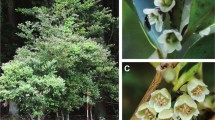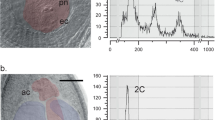Abstract
The ornaments and weapons of male animals are among the showiest and seemingly most wasteful of nature's productions. Darwin's theory of sexual selection showed how such traits could be selected through competition for mates even if they were otherwise detrimental1. Flowering displays of plants often show a comparable degree of gaudiness and profligacy, but exploration of the role of sexual selection in plants has only just begun2–5. Bateman6 argued that sexual selection is caused by the greater ability of males than females to increase fitness by mating repeatedly, due to the females' greater energetic commitment to gametes or parental care. Similar reasoning applies to hermaphrodites2,3. In hermaphroditic milkweeds, most young fruits are aborted7–10 and female reproduction (seeds) is limited more by resources than by pollination11. Sexual selection theory therefore predicts that traits increasing mating success will have evolved because they increase male success through pollen. Here I report that a suite of floral traits of a hermaphroditic plant is best interpreted as having evolved through the male competition component of sexual selection, a result with important implications for evolutionary studies of pollination systems.
This is a preview of subscription content, access via your institution
Access options
Subscribe to this journal
Receive 51 print issues and online access
$199.00 per year
only $3.90 per issue
Buy this article
- Purchase on Springer Link
- Instant access to full article PDF
Prices may be subject to local taxes which are calculated during checkout
Similar content being viewed by others
References
Darwin, C. R. The Descent of man in Relation to Sex (Murray, London, 1871).
Charnov, E. L. Proc. natn. Acad. Sci. U.S.A. 76, 2480–2484 (1979).
Willson, M. F. Am. Nat. 113, 777–790 (1979).
Janzen, D. H. Am. Nat. 111, 365–371 (1977).
Bawa, K. S. A. Rev. Ecol. Syst. 11, 15–39 (1980).
Bateman, A. J. Heredity 2, 349–368 (1948).
Wilbur, H. M. J. Ecol. 64, 223–240 (1976).
Willson, M. F. & Rathcke, B. J. Am. Midl. Nat. 92, 47–57 (1974).
Willson, M. F. & Price, P. W. Evolution 31, 495–511 (1977).
Chaplin, S. J. & Walker, J. L. Ecology 63, 1857–1870 (1982).
Willson, M. F. & Price, P. W. Can. J. Bot. 58, 2229–2233 (1980).
Bookman, S. S. Am. J. Bot. 68, 675–679 (1981).
Wyatt, R. Am. J. Bot. 63, 845–851 (1976).
Kephart, S. R. Am. J. Bot. 68, 226–232 (1981).
Morse, D. H. Ecology 62, 89–97 (1981).
Morse, D. H. Oecologia 53, 187–196 (1982).
Bookman, S. S. Evolution (in the press).
Stephenson, A. J. A. Rev. Ecol. Syst. 12, 253–279 (1981).
Author information
Authors and Affiliations
Rights and permissions
About this article
Cite this article
Queller, D. Sexual selection in a hermaphroditic plant. Nature 305, 706–707 (1983). https://doi.org/10.1038/305706a0
Received:
Accepted:
Issue Date:
DOI: https://doi.org/10.1038/305706a0
This article is cited by
-
Ovule positions within linear fruit are correlated with nonrandom mating in Robinia pseudoacacia
Scientific Reports (2016)
-
Pollen and resource limitations to lifetime seed production in a wild population of the endangered plant Disanthus cercidifolius var. longipes H. T. Chang (Hamamelidaceae)
Frontiers of Biology in China (2007)
-
A theory for exaggerated secondary sexual traits in animal-pollinated plants
Evolutionary Ecology (2007)
-
Insect Choice and Floral Size Dimorphism: Sexual Selection or Natural Selection?
Journal of Insect Behavior (2005)
-
Effects of male sterility on reproductive traits in gynodioecious plants: a meta-analysis
Oecologia (2003)
Comments
By submitting a comment you agree to abide by our Terms and Community Guidelines. If you find something abusive or that does not comply with our terms or guidelines please flag it as inappropriate.



